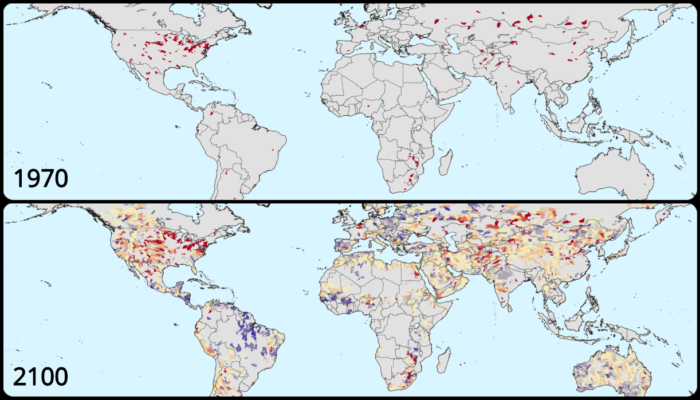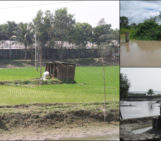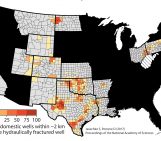
Post by Inge de Graaf, Assistant Professor of Hydrological Environmental Systems at the University of Freiburg.
With the climate strikes happening all over the world, I sometimes wish I had a crystal ball that would allow me to look into the future. Or even better, a crystal ball that could show me different scenarios of what will happen if we change, or not.
Well, I do not have a crystal ball, but I do have a global scale hydrological model. I use this model to glimpse into the future and see what will happen to our rivers and streams if we keep pumping groundwater like we do now. Me and my co-authors recently published a paper on this in Nature.
Over the last 50-years strong population growth and economic development have led to a large increase in freshwater demand, especially for the irrigation of food crops. About half of the water used for irrigation is pumped from groundwater. In many dry regions around the world, more groundwater is pumped than recharged from rain, causing water levels to drop. When the water levels drop, the flow of groundwater to rivers and streams will reduce. As a consequence, river flows will decline (or even completely dry up) and water temperatures will rise, forming a major threat to fish and water plants.
In our study, we used a new global-scale hydrological model to investigate how freshwater ecosystems have been, and will be, affected by groundwater pumping. Using the model, I am able to calculate the flow of groundwater to rivers all over the world. This allows me to study how a reduction of this groundwater flow, when it is pumped, impacts river flow.
Our calculations show that almost 20% of the regions where groundwater is pumped currently suffer from a reduction of river flow, putting ecosystems at risk. We expect that by 2050 more than half of the regions with groundwater abstractions will not be able to maintain healthy ecosystems. Our estimates of when and where critical river flows are first reached are presented in Figure 1.

Figure 1. First year critical river flow is reached and aquatic ecosystems are threatened due to groundwater pumping.
The most striking insight is that only a small drop of groundwater level will already cause these critical river flows (Figure 2). Moreover, the impact of groundwater pumping will often become noticeable after years, or decades. This means that we cannot detect the future impact of groundwater pumping on rivers from the current levels of groundwater decline. It really behaves like a ticking time bomb.

Figure 2. Groundwater level drop that causes critical river flows to be reached.
We already see the negative impact of groundwater pumping on river flows in Central and Western United States and in the Indus river basin in Asia. If groundwater pumping continues as it is now, we expect negative impacts to occur in Southern and Eastern Europe, North Africa, and Australia in the coming decades. Climate change will accelerate this process.
Although seeing the consequences of groundwater pumping on the environment globally is rather shocking, I am still optimistic about the future. I hope we can raise awareness on a slowly evolving crisis. A reduction of groundwater pumping will be the only way to prevent negative impacts, while at the same time, global food security should be maintained. Groundwater should be used more sustainably. It is important to develop more efficient irrigation techniques worldwide and experiment with crops that use less freshwater or can live in salty water.
If you would like to read about this research of mine in more detail, read my publication Environmental flow limits to global groundwater pumping.
I conducted this work with my co-authors Tom Gleeson (University of Victoria), L.P.H. (Rens) van Beek, Edwin H. Sutanudjaja, and Marc F.P. Bierkens (all form Utrecht University).
de Graaf, I. E. M., Gleeson, T., (Rens) van Beek, L. P. H., Sutanudjaja, E. H. & Bierkens, M. F. P. Environmental flow limits to global groundwater pumping. Nature 574, 90–94 (2019).




Christy W Songola
A well written post. Clearly presents the best problem at hand, the challenge for water scientists and every soul on the planet and expounds on the remedies there of. As imperative as it is to understand the challenge, more attention has to be on the mitigation measures and sustainable solutions to this challenge. It is very true that reducing groundwater pumping significantly helps preventing the negative impacts, but the challenge comes when we have to meet the world’s evergrowing food demands, not to mention other equally important water uses; direct consumption and industrial production